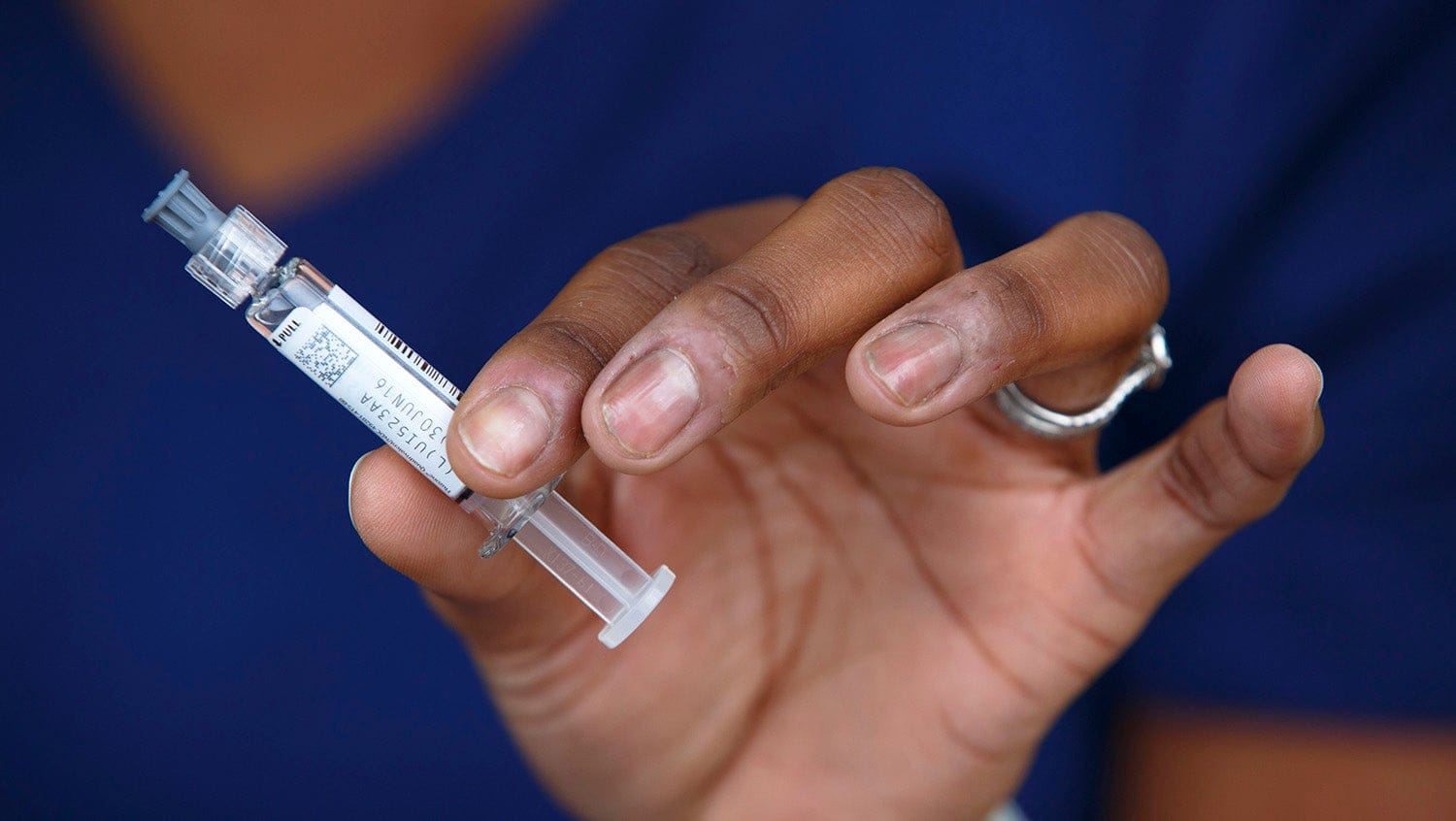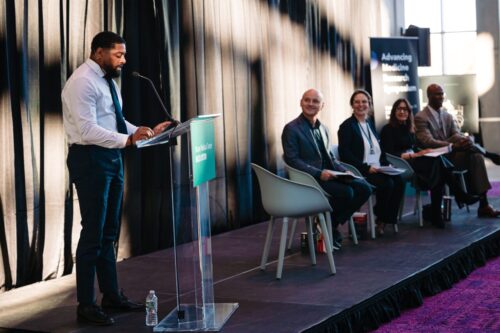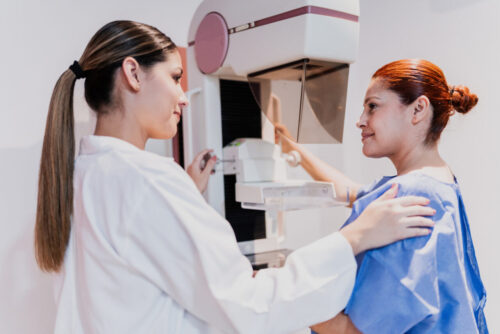Fighting Vaccine Hesitancy in Groups Hardest Hit by COVID-19
December 10, 2020

Getty Images
Transparency and culturally appropriate communication are key to counteracting the hesitancy that could diminish the impact of a COVID-19 vaccine.
COVID-19 in the U.S. has disproportionately impacted Black and Latinx communities. Now that vaccines are getting ready to go to market, Black and Latinx patients are hesitant to get in line. A recent national survey took a look into COVID-19 vaccination concerns, finding that less than half of Black adults and only two-thirds of Latinx adults surveyed expressed intent to get a vaccine when it becomes available.
This vaccine hesitancy — experienced by those who are reluctant or decline to become vaccinated — may stem from a history of events that have cultivated a deep distrust in the medical system, including the Tuskegee study, in which Black men in the South were blocked access to treatment for syphilis because researchers wanted to learn the disease’s progression, and the experience of Henrietta Lacks, a Black woman with cancer whose cells were used for generations of research without her consent. More recently, misinformation and missteps in the Trump administration’s handling of data for new treatments have caused further concern.
The World Health Organization lists vaccine hesitancy as one of the top threats to global health. It threatens to reverse progress that has been made in preventing the spread of COVID-19 and prolong the pandemic and its impact in Black and Latinx communities. SARS-CoV-2 (the virus that causes COVID-19) may become a preventable virus, but it’s the vaccination, not the vaccine that will save lives, says Sabrina Assoumou, MD, MPH, an infectious diseases physician at Boston Medical Center (BMC).
Assoumou joined HealthCity and Ricardo Cruz, MD, MPH, an internal medicine physician at BMC to discuss the importance of equity in the process of building trustworthiness and the work that needs to be done to better provide education and fight the misinformation that is influencing people’s decisions.
HealthCity: In your experience, what’s driving COVID-19 vaccine concerns in Black and Latinx communities?
Sabrina Assoumou, MD, MPH: From a contemporary perspective, my Black patients discuss their personal experiences with the healthcare system, where they feel like they weren’t listened to or weren’t provided sufficient access to certain resources. Misinformation has also played a rampant role for people, especially with the expansion of social media. We have a long way to go in terms of reassuring our patients and educating them on the what vaccination can mean for a community and what the scientific advances can mean for public health.
Ricardo Cruz, MD, MPH: There are cultural and linguistic issues when it comes to vaccine hesitancy. For many of my Latinx/BIPOC patients, at some point in their life they experienced something concerning that led to mistrust in the healthcare system. We see patients who have limited English proficiency and need qualified interpreter services or a bilingual provider to ensure that they are appropriately counseled, offered various treatments, and explained their condition in entirety. Patients who do not receive this service walk away not understanding what to do next or feeling like they were pushed into receiving a particular treatment, whether it be a vaccine or something else.
It is also important to note the different cultures involved. For example, in Latinx cultures, there is a concept called fatalismo, or fatalism, in which a person’s fate is predetermined, and nothing can be done to impact that, including preventative health measures and vaccines. Cultural aspects like this are something providers need to be educated on and work with to address.
HC: Has the pandemic response influenced vaccine hesitancy?
RC: For some people who were sick or caring for a sick family member or friend, their social determinants of health weren’t being addressed and they weren’t able to access testing in a timely fashion. A lot of these people were suffering from job insecurity, housing insecurity, food insecurity, and may not have been able to actively work to address both their health and their economic/social conditions. Some people are also frontline essential workers — that’s how they were becoming infected with the virus. By not addressing both health and economical/social conditions in a timely fashion during the first wave, you can anticipate pushback from the community that may have felt abandoned by the healthcare and public health systems. They may think, “Why now? When I was suffering from not being able to pay my rent, public health was not there to save me.” You can see how a lot of this can contribute to some hesitancy right now.
It’s complex, but addressing people’s basic needs may help restore trust in these systems.
HC: What should we be doing to ultimately improve vaccine acceptance rates?
SA: Providing the most basic information about vaccines — what we have, what we need, why we get vaccinated, and why it is so important — is key to educating people right now. For vaccines to actually have true impact, we need to have expansive coverage, so we need to be ready to communicate all information transparently to our patients and start thinking in advance about rolling out the vaccine.
We should also be identifying the trusted leaders in the communities we are trying to reach. In the Black community, the pastors and elders in the church are often the most trusted. To have a champion in the community that’s already identified, who can help share this information, is an important step.
RC: We missed a big opportunity in trying to address vaccine hesitancy early, but there’s still time. There’s information out there in the news and on social media scaring patients into thinking they are going to get sick from the vaccine. This has a lot to do with health literacy — patients’ understanding of what a vaccination is and what the normal side effects are. It’s hard nowadays for people to distinguish between what’s a false narrative and what’s actually a fact.
As healthcare professionals, we must try our best to counteract misinformation by ensuring we educate our patients in a way that they’re going to understand, it in a culturally and linguistically appropriate, patient-centered fashion. In the Latinx community, it also comes down to churches, businesses, community health centers, day centers for the elderly population. Educating and utilizing trusted community members, including community peers or health workers, to do this outreach to try to address this is going to be key.
HC: Can clinicians leverage other resources to accomplish outreach goals?
SA: Piggy-backing on other existing programs in the community will be important. You don’t have to set up a new program for this; just look at how have we already been in the community, and use that infrastructure. For instance, Pittsburgh’s Neighborhood Resilience Program developed a Community Health Deputy Initiative to increase vaccine participation via health deputies from the community going in and building trust.
Some hospitals, including BMC, are already set up for the vaccine trials, so we are looking at how can we use that infrastructure to help people get the vaccine and support patients through the process.
“If we can’t expect people to show up and come to us, how do we go to them?”
Throughout the initial surge we also saw pediatricians going into the community, being creative with ambulances as mobile clinics to make sure that the children were getting their other vaccinations. The thought is, “Okay, we need to get this done, how do we go about it? If we can’t expect people to show up and come to us, how do we go to them?” It was a really creative way to adapt to the new normal during the pandemic and a model healthcare should use moving forward.
HC: Looking forward to a potential rollout, what are your concerns and where do the opportunities lie?
SA: Every clinician should be asking their patients, “What are your thoughts about vaccines? What questions do you have?” so we can make patients feel comfortable to get vaccinated and protect others. We need to make sure that communities that have been disproportionately impacted actually have access to the vaccine and have been provided the education that they need.
RC: The primary thing about the rollout of the COVID-19 vaccine is we want to make sure it’s equitable, with a focus on the why, how, and where. My concern is the logistics. We need to get messaging out ASAP about how it functions, understanding that this is a new technology for people. We need informational sheets out in the community that are culturally and linguistically appropriate, and we need to highlight that this is a two-dose vaccination, so people know to come back for their second dose.
It’s never too early to start doing this outreach and discussing this. It’s something that we need to address now, or else we’re going to have folks slip through the cracks, and we’re not going to get the vaccination rate that we need.
This interview has been edited and condensed.


